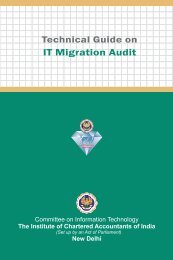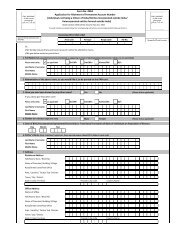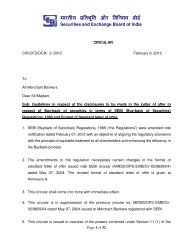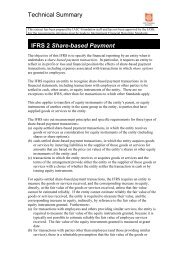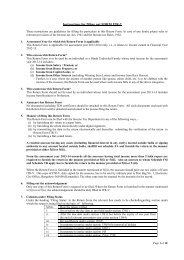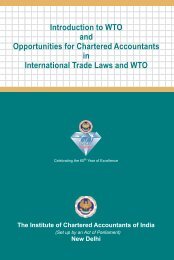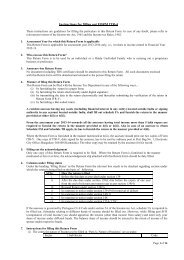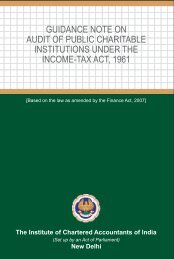Swarna Jayanti Shahari Rozgar Yojana (SJSRY) - CAalley.com
Swarna Jayanti Shahari Rozgar Yojana (SJSRY) - CAalley.com
Swarna Jayanti Shahari Rozgar Yojana (SJSRY) - CAalley.com
You also want an ePaper? Increase the reach of your titles
YUMPU automatically turns print PDFs into web optimized ePapers that Google loves.
VOperational Guidelines for Skills Training for EmploymentPromotion amongst Urban Poor (Step-Up)VIVIIVIIIIXXXICommunity-Based Structures to be Set Up under <strong>SJSRY</strong>Formats for Submission of Proposals for Innovative/Special Projects under <strong>SJSRY</strong>Report showing the cumulative position for themonth ended ----- under the USEP <strong>com</strong>ponent of<strong>SJSRY</strong>Recovery Position (cumulative ) under <strong>SJSRY</strong> forthe half year ended Sept. / MarchX f F Format Showing the monthly progress reportto be sent to to ttto the state and Ministry of HUPAList o Circulars that have been consolidated in theMaster Circul Circular
1.Introduction1.1. The <strong>Swarna</strong> <strong>Jayanti</strong> <strong>Shahari</strong> <strong>Rozgar</strong> <strong>Yojana</strong> (<strong>SJSRY</strong>) was launched on01.12.1997 after subsuming the earlier three schemes for urban povertyalleviation, namely Nehru <strong>Rozgar</strong> <strong>Yojana</strong> (NRY), Urban Basic Services for thePoor (UBSP), and Prime Minister's Integrated Urban Poverty EradicationProgramme (PMIUPEP). The key objective of the Scheme is to provide gainfulemployment to the urban unemployed or underemployed through the setting up ofself-employment ventures or provision of wage employment.1.2 To over<strong>com</strong>e the difficulties faced by the States / UTs and address certaindrawbacks in the implementation of <strong>SJSRY</strong>, the Guidelines of the Scheme havebeen revised. It is presumed that the revised guidelines will assist in the effectiveimplementation of <strong>SJSRY</strong> and make a dent on the urban poverty scenario in thecountry. The Revised Guidelines have <strong>com</strong>e into effect from 1.4.2009.2. <strong>Swarna</strong> <strong>Jayanti</strong> <strong>Shahari</strong> <strong>Rozgar</strong> <strong>Yojana</strong>: Salient FeaturesObjectives2.1. The objectives of the revised <strong>Swarna</strong> <strong>Jayanti</strong> <strong>Shahari</strong> <strong>Rozgar</strong> <strong>Yojana</strong>(<strong>SJSRY</strong>) are :* Addressing urban poverty alleviation through gainful employment to theurban unemployed or underemployed poor by encouraging them to set upself employment ventures (individual or group), with support for theirsustainability; or undertake wage employment;* Supporting skill development and training programmes to enable theurban poor have access to employment opportunities opened up by themarket or undertake self-employment; and* Empowering the <strong>com</strong>munity to tackle the issues of urban poverty throughsuitable self- managed <strong>com</strong>munity structures like Neighborhood Groups
eneficiaries with emphasis on those given a higher priority on the basis ofnoneconomic criteria. Beneficiaries should declare that they have not availedsimilar benefits under any other self-employment scheme. The list ofbeneficiaries is to be shared with PMEGP to rule out duplication of coverage.4.2.9. For the purpose of self-employment, focus will be on 3 sectors i.e.Production (Micro-industry), Services and Business.4.2.10. On Micro-industry (Manufacturing) side, a group of people (hub)will be encouraged for setting up of enterprises centered around andsupported by Micro Business Centres (MBC), established following clusterapproach. Space may be provided by MBCs in the form of working sheds ormicro-entrepreneurs may work from their homes.4.2.11. In relation to Services sector, Urban Local Bodies will provide Seva/ Suvidha Kendras (for every 50,000 population at least one Kendra) withsuitable logistics and space. Workers will register themselves with theKendras, which could act as focal points for the servicing trades andfacilitate jobs / assignments to the registered skilled workers on demandfrom the clients. The emphasis will be on quality skills and the rates will bedecided in advance / fixed for home visits.4.2.12. In Business Sector, i.e. shop-based enterprises, kiosks / spaceswill be leased out by the ULBs to the urban poor for setting up shops.Vendors' markets will be promoted. Mobile vending outlets, running onmotorized scooters will be encouraged with suitable technologicalinterventions. Beneficiaries can also run their ventures from their ownhouses / shops.4.2.13. Opportunities in the transport sector, viz. running of scooterrickshaws, motorized cycle rickshaws for ferrying people / goods will beexplored. Group ownership / Occupational Credit Groups concept in thissector will also be encouraged.
4.2.14. Micro-business Centres can be planned to cover Services andBusiness sectors, apart from Micro-industry. For businesses they can helpwith project preparation, permissions from planning and regulatory agencies,maintenance of accounts, advertisement, packaging, branding, decidingmaximum retail price, marketing, etc.4.2.15. The details of financing pattern under USEP are as follows :Maximum allowable unit projectcostMaximum allowable subsidyBeneficiary contributionCollateral- Rs.200,000/-- 25% of the Project Cost subject to amaximum of Rs.50,000/-- 5% of the project cost as marginmoney- No Collateral requiredAnnexure II may be seen for operational details of USEP.4.2.16. <strong>SJSRY</strong> will encourage group formation by the urban poor forsetting up micro enterprises. In case a number of beneficiaries, either maleor a mixed group consisting of males and females, decide to jointly set up aproject, such project will be eligible for a subsidy, which will be equal to thetotal sum of permitted subsidy per person as per the above criteria. In thiscase too, the provision relating to 5% margin money per beneficiary willapply. The overall project cost, which can be permitted, will be the simplesum of the individual project cost allowable per beneficiary.4.3. Technology, Marketing and Other Support4.3.1. This <strong>com</strong>ponent will mainly focus on handholding support for theurban poor entrepreneurs who want to be self-employed and set up their
own small businesses or manufacturing units. Under this <strong>com</strong>ponent, Micro-Business Centres (MBC) will be established at cluster level (e.g. handlooms/ handicrafts, food processing, construction, glass & ceramics, electrical andelectronics, mechanical engineering, auto driving & mechanics, metal works,etc.), supported with one-time capital grant subject to the concerned StateGovernment / Urban Local Body providing the required land free of cost.This will be run on the basis of a Public-Private-Partnership (P-P-P) model.MBCs could also be run by the society of entrepreneurs themselves withmanpower hired on contract basis.4.3.2. Small Enterprise Advisory Services (SEAS) will be provided throughthe MBC which may be equipped with specialists covering 5 key areas : (1)Community Mobilization including Survey and Identification of Beneficiaries,Cluster Development, etc. (2) Capacity Building including Skill &Entrepreneurship Development, (3) Business Development, (4) Finance &Credit, and (5) Marketing. These specialists, who may be paid remuneration<strong>com</strong>mensurate with their education and experience, will undertakehandholding activities for the development of entrepreneurs from the urbanpoor <strong>com</strong>munity and promote business development by them from theconcept stage to <strong>com</strong>missioning to sustainability. The MBCs & SmallEnterprise Advisory Services (SEAS) will specially focus on handholding theurban poor micro-entrepreneurs who have opted for self-employment, with aview to enhancing the success rate of micro enterprises. Operativeguidelines for MBCs and SEAS will be issued by the respective States / UTsadopting a cluster-based approach.4.3.3. A Micro Business Centre under the Scheme can be provided afinancial support not exceeding Rs.80 lakhs per MBC (one time capital grantof Rs.60 Lakhs + Rs.20 Lakhs for running cost on a tapered scale, to sustainthem). Efforts should be made to make these MBCs self-sustainable in duecourse. For this, MBCs may involve themselves in business, consultancies
and other in<strong>com</strong>e generation activities. As micro-businesses prosper, theycan also charge fees.4.3.4. Technology, marketing, consultancy (advice) & other support mayalso be provided to beneficiaries setting up micro-enterprises, in relation toproduction and marketing of their products etc. This can be ac<strong>com</strong>plished byproviding selling places for the poor in the form of kiosks and rehri markets,setting up of Nagar Palika Seva / Suvidha Kendras for construction andother services (like those provided by carpenters, plumbers, electricians, TV/ radio / refrigerator mechanics etc. who will be available to city residents oncall), and through liaison for provision of weekend markets / evening marketsin municipal grounds or on road sides on the one hand and technicalassistance in relation to market surveys / trends, joint brand names / designsand advertising on the other. Community Development Societies (CDSs) willprovide all needed help including securing of raw materials and marketing ofproducts by the urban poor.4.3.5. It is also proposed that a Service Centre be set up at the CDS levelfor those who have undergone skill upgradation training. Appropriate spacemay be provided to trained persons who can be asked to enroll themselveswith the Service Centre so that they could be sent to attend day-to-dayskilled tasks on call from citizens against appropriate scales of paymentfixed by the Community Development Society (CDS). Appropriate publicitymay be done within the town regarding the facilities available under theService Centre. The Service Centre can survey manpower needs of localindustry and other potential employers and match them to the job seekers,as also to help organize appropriate skill training.4.3.6. Special assistance may be provided for setting up of Communitylevel Service centres, which could be used for multifarious activities such aswork places / branding / marketing centres etc. for beneficiaries under thisprogramme. These may be administered on a day-to-day basis by the local
CDS. Space for such centres should be provided free of cost either by thelocal body or any other agency.4.3.7. The construction of the Seva / Suvidha Kendra shall follow thenorms laid down under the Scheme of Urban Wage EmploymentProgramme.4.3.8. Clusters of micro-production units may be developed in keeping withthe factors of localization pertaining to traditional skills and in terms of townsknown for specific products. Appropriate or intermediate technology inputsmay be used to strengthen the technological base of the selected clusters interms of Common Facility Centres providing critical machinery / equipmentrequired for <strong>com</strong>mon use by clusters of microenterprises as well as ensuringsupply of quality raw materials at reasonable prices. These Common FacilityCentres may be run by associations of micro-entrepreneurs themselvesrelated to the selected economic activity. Entrepreneurs should be providedhigh quality Small Enterprise Advisory Services (SEAS).4.3.9. Micro-entrepreneurs should be encouraged in developing tradebasedorganisations / associations. Mobile vending outlets may bedeveloped with technological design and development support from IITs andother reputed institutions. An integrated approach may be adopted withspecial attention to backward and forward linkages for a <strong>com</strong>plete range ofactivities in the establishment of the enterprises.4.3.10. Total expenditure on this <strong>com</strong>ponent of Technology / Marketing /Knowledge / Infrastructure & Other support provided to the urban poor insetting up their enterprises as well as marketing their products, may notexceed 10% of the total funds earmarked for the USEP <strong>com</strong>ponent.5. Urban Women Self-Help Programme (UWSP)5.1. This Component will be having two sub-<strong>com</strong>ponents:
(i) Assistance to groups of urban poor women for setting up gainful selfemployment ventures - UWSP (Loan & Subsidy)(ii) Revolving Funds for Self-Help Groups (SHGs) / Thrift & CreditSocieties (T&CSs) formed by the urban poor women - UWSP (RevolvingFund).5.2 Urban Women Self-Help Programme (Loan & Subsidy)5.2.1. This scheme is distinguished by the special incentive extended tourban poor women who decide to set up self-employment ventures in agroup as opposed to individual effort. Groups of urban poor women maytake up an economic activity suited to their skill, training, aptitude, and localconditions. Besides generation of in<strong>com</strong>e, this group strategy will strive toempower the urban poor women by making them independent as alsoproviding a facilitating atmosphere for self-employment. Under UWSP, anactivity-focused area-specific approach will be adopted for setting up micro /group enterprises with emphasis on micro-finance.5.2.2. To be eligible for subsidy under this scheme, the UWSP groupshould consist of at least 5 urban poor women. Before starting an in<strong>com</strong>egeneratingactivity the group members must get to know each other well,understand the group strategy, and also recognize the strength and thepotential of each member of the group. The group will select an organizerfrom amongst the members. The group will also select its own activity. Careshould be exercised in the selection of activity because the future of thegroup will rest on the appropriateness of the selection. As far as possible,activities should be selected out of an identified shelf of projects for the areaconcerned maintained by the town Urban Poverty Alleviation Cell. Inaddition, every effort will be made to encourage the group to set itself up asa Self-Help Group or Thrift & Credit Society, mobilizing savings and credit.
5.2.3. For setting up group enterprises, the UWSP group shall be entitledto a subsidy of Rs.300,000/- or 35% of the cost of project or Rs.60,000/- perMember of the Group, whichever is less. The remaining amount will bemobilized as Bank Loan and Margin Money. Operation details of UWSP maybe seen at Annexure III.5.3. Urban Women Self-Help Programme (Revolving Fund)5.3.1. Where the UWSP group sets itself up as a Self-Help Group (SHG) /Thrift & Credit Society (T&CS), mobilizing savings and credit in addition to itsother entrepreneurial activities, the SHG / T&CS shall also be entitled to alump sum grant of Rs.25,000/- as Revolving Fund at the rate of Rs.2000/-maximum per member. This Revolving Fund shall be available to a simpleSelf-Help Group / Thrift & Credit Society also, even if the society is notengaged in any project activity or enterprise under UWSP. This fund ismeant for the use of the SHG / T&CS for purposes such as :(i)Purchases of raw materials and marketing;(ii) Infrastructure support for in<strong>com</strong>e generation and other groupactivities;(iii) One-time expense on child care activity. Recurring expenses likesalary for staff etc. will not be permissible;(iv) Expenses not exceeding Rs.500/- to meet travel costs of groupmembers for visit to banks, town UPA Cell etc;(v) Where an individual member of a Thrift & Credit Society / Self-Help Group saves at least Rs.500/- in a fixed deposit for 12 monthswith the society, she will be entitled to a subsidy of Rs.30 to be paidon her behalf towards a health / life / accident / any other insurancescheme for herself. Moreover, in cases where the member saves at
least Rs.750 in a fixed deposit in 12 months, she will be entitled to asubsidy of Rs.60, at the rate of Rs.30 for the member herself andeither Rs.30 for her husband towards health / life / accident / any otherinsurance or Rs.30 for any minor girl child in her family for health /accident insurance. This expense may also be debited to the revolvingfund; and(vi) Any other expense allowed by the State / ULB as beingnecessary in the society or group's interest based on guidelines.5.3.2. A Self-Help Group / Thrift and Credit Society under UWSP shall beentitled for payment of revolving fund not earlier than one year after itsformation. In other words, only such a body, in existence and functioning forat least one year, shall be eligible for payment of the revolving fund. Thedecision whether a group has been in existence and functioning for morethan one year shall be taken on the basis of examination of the records ofthe group as regards the number of meetings held, the collections madefrom members towards group savings, the regularity of collection, the role ofthe group in capacity building or training of its members etc. The registrationof the groups will be encouraged. However, it may not be insisted upon as aprecondition for receipt of revolving fund if their performance is otherwiseconsidered satisfactory by the Urban Poverty Alleviation (UPA) Cell of theUrban Local Body (ULB). Federations of SHGs / T&CS at the cluster / ward /city level will need to be registered for channelisation of Revolving Fund,bank credit etc. States / UTs will issue guidelines prescribing eligibilitycriteria for receipt of revolving fund benefits by groups.5.3.3. Self-Help Group / Thrift & Credit Society - Bank linkage will beaccorded priority under <strong>SJSRY</strong>. SHG / T&CS will be encouraged to availbank credit, on the basis of their performance, for their requirements.Flexibility is provided to States / UTs for the involvement of financialinstitutions / cooperatives / cooperative banks / NGOs active in the micro-
credit field and other micro-finance institutions like Rashtriya Mahila Kosh(RMK), SEWA, NABARD, SIDBI, ICICI Bank etc., wherever desirable, forproviding micro-finance to the Self-Help Groups of women. Suitableguidelines in this regard may be issued by the Ministry of Housing & UrbanPoverty Alleviation from time to time. Indicative principles for the operation ofSelf-Help Groups / Thrift & Credit Societies are at Annexure IV.6. Skill Training for Employment Promotion amongst Urban Poor (Step-Up)6.1. This <strong>com</strong>ponent of <strong>SJSRY</strong> will focus on providing assistance for skillformation / upgradation of the urban poor to enhance their capacity to undertakeself-employment as well as access better salaried employment.6.2. Like USEP, STEP-UP will target the urban population below poverty line, asdefined by the Planning Commission from time to time. The percentage of womenbeneficiaries under STEP-UP shall not be less than 30%. SCs and STs must bebenefited at least to the extent of the proportion of their strength in the city / townpopulation below poverty line (BPL). A special provision of 3% reservation shouldbe made for the differently-abled, under this programme. In view of the PrimeMinister's New 15-Point Programme for the Welfare of Minorities, 15% of thephysical and financial targets under the Skill Training for Employment Promotionamongst Urban Poor (STEP-UP) at the national level shall be earmarked for theminority <strong>com</strong>munities.6.3. STEP-UP intends to provide training to the urban poor in a variety ofservice, business and manufacturing activities as well as in local skills and localcrafts so that they can set up self-employment ventures or secure salariedemployment with enhanced remuneration. Training should also be imparted invital <strong>com</strong>ponents of the service sector like the construction trade and alliedservices such as carpentry, plumbing, electrical and also in manufacturing lowcostbuilding materials based on improved or cost-effective technology using localmaterials.
6.4. Skill Training may be linked to Accreditation, Certification and preferably betaken on Public-Private-Partnership (PPP) mode with the involvement of reputedinstitutions like IITs, NITs, Industry Associations, reputed Engineering Colleges,Management Institutes, Foundations and other reputed agencies. Traininginstitutions such as ITIs / Polytechnics / Shramik Vidyapeeths, EngineeringColleges and other suitable institutions run by Government, private, or voluntaryorganizations may be utilized and provided appropriate support for skills training ofthe urban poor subject to verification of their brand image and quality ofinstructions being imparted. Services of the Building Centres sponsored by theHousing & Urban Development Corporation (HUDCO) / Building MaterialTechnology Promotion Council (BMPTC) within the States / UTs may be utilizedfor the purpose of construction-related training, as per the local requirements.6.5. The average unit cost allowed for training will not exceed Rs.10,000/- pertrainee, including material cost, trainers' fees, tool kit cost, other miscellaneousexpenses to be incurred by the training institution and the monthly stipend, to bepaid to the trainee. Indicative operational details for Skill Training for EmploymentPromotion amongst Urban Poor are provided in Annexure V.7. Urban Wage Employment Programme (UWEP)7.1. This programme seeks to provide wage employment to beneficiaries livingbelow the poverty line within the jurisdiction of urban local bodies by utilising theirlabour for construction of socially and economically useful public assets. Theseassets may be Community Centres, Storm water Drains, Roads, Night Shelters,Kitchen Sheds in Primary Schools under Mid-day Meal Scheme and other<strong>com</strong>munity requirements like Parks, Solid Waste Management facilities, asdecided by the <strong>com</strong>munity structures themselves. The Urban Wage EmploymentProgramme (UWEP) will be applicable only to towns / cities with population upto 5Lakhs, as per the 1991 Census.
7.2. UWEP will provide opportunities for wage-employment, especially for theunskilled and semi-skilled migrants / residents by creation of <strong>com</strong>munity assets.Special emphasis will be on the construction of <strong>com</strong>munity assets in low-in<strong>com</strong>eneighbourhoods with a strong involvement and participation of local <strong>com</strong>munities.7.3. The material : labour ratio for works under this programme shall bemaintained at 60:40. However, States / UTs can relax this material : labour ratioup to 10% (either way), wherever absolutely necessary. The prevailing minimumwage rate, as notified from time to time for each area, shall be paid tobeneficiaries under this programme.7.4. Community Development Societies (CDSs) shall survey and draw up a listof available basic minimum services in their areas. Missing basic minimumservices shall be first identified. Other requirements of physical infrastructure shallbe listed thereafter.7.5. As far as possible, works are to be executed through CDSs, under thegeneral control and supervision of the ULBs. ULBs are expected to maintain aclose watch over the quality of construction. Work must be done departmentallyand detailed guidelines as regards maintenance of muster rolls, social audit etc.will be issued in this regard by the concerned State / UT Governments. To theextent possible, even the material <strong>com</strong>ponent of the work should be donedepartmentally. Where departmental work is not possible due to the specializednature of the work involved, such material <strong>com</strong>ponent of the work may be gotdone through agencies by following proper tendering / Government procedure.7.6. In all cases it must be ensured that the works undertaken under UWEP arebrought to a safe stage and no work is left in<strong>com</strong>plete or pending half-way. In caseof cost escalation, or expansion in the nature of the work, or increase in theproject estimate for any other reason whatsoever, and if additional funds are notavailable under this programme, it shall be the basic responsibility of thesanctioning authority / implementing authority i.e. Urban Local Body / District
Urban Development Agency to ensure the <strong>com</strong>pletion of such works by bringing inadditional resources from other programmes / own resources, if so required.7.7. Wage employment should be used very sparingly, only for short-termmeasures till the beneficiary is able to get the benefits of skill development for selfemploymentventures or employment in the formal sector.8. Urban Community Development Network (UCDN) - Community Structures,Community Development & Empowerment8.1. <strong>SJSRY</strong> shall rest on the foundation of <strong>com</strong>munity development andempowerment. Rather than relying on the traditional method of top-downimplementation, the Scheme shall rely on establishing and nurturing <strong>com</strong>munityorganizations and structures that facilitate sustained urban poverty alleviation.Towards this end, <strong>com</strong>munity organizations like Neighbourhood Groups (NHGs),Neighbourhood Committees (NHCs), and Community Development Societies(CDSs) shall be set up in the target areas. Details of these <strong>com</strong>munity structuresare given at Annexure VI. The CDSs will be the focal points for purposes ofidentification of beneficiaries, preparation of loan and subsidy applications,monitoring of recovery, and generally providing whatever other support isnecessary for the programmes. The CDSs will also identify viable projects suitablefor the area. Promotion of women self-help groups will be an important activity tobe pursued by CDSs.8.2. The <strong>com</strong>munity structures may also set themselves up as Self-Help Groups(SHGs) / Thrift and Credit Societies to encourage <strong>com</strong>munity savings and othergroup activities. However, Self-Help Groups and Thrift and Credit Societies mayalso be set up separately from the CDS as well. The CDS, being a federation ofdifferent <strong>com</strong>munity based organizations, may be the nodal agency for promotionof self-help groups and thrift and credit. It is expected that the CDSs will layemphasis on providing the entire gamut of social sector inputs in their areasincluding, but not limited to, livelihoods, skill development, shelter, water,
sanitation, health, education, social security, welfare, etc. through theestablishment of convergence between various schemes being implemented bydifferent line departments.8.3. At the <strong>com</strong>munity level a Community Organizer (CO) may be engaged forabout 2,000 identified families. Such Community Organizer should, as far aspracticable, be a woman. She should be a full-time functionary. If not recruitedunder the earlier programmes, the CO may be engaged on a contract basis. Sheshould be paid suitable remuneration <strong>com</strong>mensurate with her qualification andexperience.8.4. The Community Organizer (CO) will be the main link between the urbanpoor <strong>com</strong>munity (represented through the CDS) and the implementationmachinery i.e. Urban Poverty Alleviation Cell at the ULB level. The success of theScheme relies upon the performance of the COs. The major responsibilities of aCO include:(i) Facilitating and promoting voluntarism and organizing <strong>com</strong>munitystructures / groups;(ii) Guiding and assisting the <strong>com</strong>munity in assessing its needs, organising<strong>com</strong>munity structures, developing a <strong>com</strong>munity vision, and formulating<strong>com</strong>munity development action plans;(iii) Coordinating the conduct of Slum, Households and Livelihoodssurveys and maintaining database on the urban poor and their needs;(iv) Working with the <strong>com</strong>munity to implement and monitor <strong>SJSRY</strong> andrelated programmes or activities;(v) Assessing skill needs of the urban poor and facilitating skilldevelopment training and post-training handholding;
(vi) Liaising with the sectoral departments to establish initial contacts withthe <strong>com</strong>munity in support of their programmes;(vii) Facilitating <strong>com</strong>munity empowerment through <strong>com</strong>munity leveltraining, information sharing, exchange of experiences, <strong>com</strong>munity skillsenhancement programmes, etc.(viii) Identifying suitable beneficiaries for self-employment ventures,preparing applications for securing bank credit after approval of the namesof beneficiaries by the CDS, and taking subsequent follow up with the ULBs /Banks / Administration until final disposal of the applications.(ix) Regularly following up with the financed beneficiaries to monitor theprogress of their self-employment venture as also the timely repayment ofloans, etc.(x) Any other function as may be assigned for furtherance of the target ofalleviating / eradicating urban poverty.8.5. Funds may be released separately under UCDN <strong>com</strong>ponent, for thestrengthening of Community Structures and Community Development Networks.These can be utilized for meeting the expenditures on allowances / honorarium toCommunity Organizers (CO), <strong>com</strong>munity mobilization machinery includinganimators, holding of awareness camps / workshops / seminars / conferences /meetings involving COs, Community-Based Organisations (CBOs), NGOs andother stakeholders, miscellaneous daily activities of the CDS, etc. and any otheractivity / projects connected with <strong>com</strong>munity development and empowerment suchas surveys, preparation of Urban Poverty Reduction Strategy, Slum DevelopmentPlan and <strong>com</strong>munity level Micro-plans and Mini-plans, social audit, etc.
9. Programme Implementation - Administrative & Other Expenses (A&Oe)9.1. States / UTs shall seek to minimize unproductive expenditures. A total of5% of the State / UT allocation under <strong>SJSRY</strong> can be utilized / distributed toadministrative units and implementing agencies for A&OE purpose. However,convergence at the local level of all Central / State Government programmesconcerning the urban poor and pooling of A&OE funds from all schemes targetedat the urban poor may be carried out so as to have sufficient A&OE funds to meetthe establishment costs of city / town UPA Cells and other required expenses.9.2. For the implementation of <strong>SJSRY</strong> a proper administrative set-up ormechanism has been conceptualized. The States / UTs shall see that otherprogrammes like Jawaharlal Nehru National Urban Renewal Mission are properlycoordinated with <strong>SJSRY</strong> so as to <strong>com</strong>plement each other and avoid administrativeduplication or redundancy.9.3. At the ULB level, there shall be a Town Urban Poverty Alleviation Cell (UPACell) under the Executive Officer or Commissioner of the Municipal Corporation /Municipality, supported by a Project Officer (PO) / Assistant Project Officer (APO).The PO / APO shall be responsible for coordinating the activities of all the CDSsand COs under the ULB. This Cell will be responsible for ensuring theconvergence between activities of the CDSs, the ULB and Line Departments. TheUPA Cell will first identify the urban poor clusters and areas for setting up of<strong>com</strong>munity structures. The other functions of the UPA Cell / PO / APO includeguiding and monitoring the works of CDSs and COs, rendering assistance for thepreparation of the ULB's Poverty Sub-Plan and Budget for the Urban Poor (P-Budget), conducting slum, household and livelihoods surveys, identifyingbeneficiaries for various schemes, promoting Bank-SHG linkages, establishinglinks between the <strong>com</strong>munity structures and the ULB structures under the 74thConstitution Amendment Act, promoting convergence between variousdevelopment programmes, mobilizing human and financial resources at the city
level and monitoring programme activities by deploying suitable MIS /egovernance tools, etc.9.4. At District level, a District Urban Development Agency, i.e. DUDA or adistrict level agency / mechanism may function to coordinate the scheme andundertake capacity building activities for all ULBs within the District. This may beheaded by a District Project Officer, who may be supported with staff as required.DUDA or the district level agency will also coordinate with the District PlanningCommittee set up in the District in accordance with the Constitution 74thAmendment Act. It will liaise with Line Departments for implementing urbanpoverty alleviation and related programmes effectively. The setting up as well asfunctioning of Micro-Business Centres (MBCs) will be monitored by the DUDA ordistrict level agency based on guidelines to be issued by the States / UTs.9.5. DUDA / district level agency will also undertake coordination with Banks forthe effective implementation of self-employment programmes under <strong>SJSRY</strong>. Bankofficers should be associated in the implementation process from the stage ofbeneficiary / trade selection itself, so that there may not be any problem insanctioning of loans for microenterprises of the urban poor or their groups. At theDistrict level, District Level Banker's Committee <strong>com</strong>prising of District officials andBankers may closely monitor the scheme. In order to eliminate overlaps betweenPMEGP and <strong>SJSRY</strong>, DUDA / district level agency will closely associate with theactivities of the District Industries Centre (DIC), the implementing body for PMEGPand UPA Cells in ULBs, the implementing agencies for <strong>SJSRY</strong>. In this way, eachprogramme implementation agency will be able to keep the other informed of theareas of focus and thus eliminate duplication of services, efforts and beneficiarycoverage between PMEGP and <strong>SJSRY</strong>.9.6. At the State / UT level, State Urban Development Agency (SUDA) / StateUPA Cell / Department of the State / UT Government such as Directorate ofMunicipal Administration, closely associated with the functioning of Urban LocalBodies and having proper manpower and logistics support, may be designated as
the State / UT Nodal Agency for all urban poverty alleviation programmesincluding <strong>SJSRY</strong>. The State / UT Nodal Agency shall guide and monitor theprogramme, provide suitable policy directions, facilitate the convergence ofpolicies and programmes impacting on the urban poor and liaise with the StateLevel Bankers' Committee. The Central funds will be released to this State / UTNodal Agency, which will further distribute these funds to the DUDA / ULBs forimplementation of the scheme. The State / UT Nodal Agency will also ensure therelease of matching State share by the State / UT Government concerned,wherever called for. The State Nodal Agency will function under the designatedState Nodal Officer for <strong>SJSRY</strong>, supported by specialists in the area of povertyalleviation, livelihoods, slum development / redevelopment, <strong>com</strong>munitymobilization, social development, research and training etc.9.7. At the local level, setting up of the <strong>com</strong>munity structures (viz. NHG, NHC,CDS etc.) under the scheme may be spread gradually in the urban poor localities /clusters, in a phased manner, so as to cover the entire urban poor populationwithin a specified period of time. The administrative and other expenses can thusbe phased out accordingly as per the availability of funds. States / UTs mayensure the convergence of the implementation machinery of <strong>SJSRY</strong> with theavailable expertise / structure under Jawaharlal Nehru National Urban RenewalMission (JNNURM) so as to optimally utilise the available resources.9.8. At the State / UT level, a State Level Monitoring Committee headed by theSecretary in charge of Urban Local Bodies / SUDA having members from LineDepartments, Banks, Micro-Finance Institutions, Civil Society Organisations andother stakeholders will be set up to effectively guide and monitor the Scheme. ThisCommittee will be meeting at least once in every three months.9.9. At the National level, the Ministry of Housing & Urban Poverty Alleviationshall be the nodal Ministry. <strong>SJSRY</strong> shall be monitored and overseen by the UPADivision in the Ministry of Housing & Urban Poverty Alleviation. A SteeringCommittee headed by Secretary (HUPA) and having members from the States /
UTs, Ministry of Finance, other Ministries, RBI and other stakeholders will guideand monitor the Scheme at the Central level. This Committee will be meeting atleast once in every three months.9.10. Progress of the Scheme will be monitored at the National level throughQuarterly Progress Reports (QPRs) from the States / UTs. In addition, field visitsby the officers of Ministry of Housing & Urban Poverty Alleviation, supported byselect resource centres / agencies, will be undertaken on regular basis to reviewthe actual implementation at ground level. Periodic review meetings will also beheld at National / State level for reviewing the performance of the Scheme.9.11. A dedicated cadre / service of officers specializing in urban povertyalleviation / <strong>com</strong>munity mobilization and development may be set up forsupporting the implementation of urban poverty alleviation and relatedprogrammes in the States / UTs. These officers will be appointed at ULB / District /State levels, with suitable promotion avenues, for implementation of various urbanpoverty alleviation schemes including <strong>Swarna</strong> <strong>Jayanti</strong> <strong>Shahari</strong> <strong>Rozgar</strong> <strong>Yojana</strong>(<strong>SJSRY</strong>) with a professional approach.9.12. The States / UTs may prescribe detailed procedural guidelines for theimplementation of <strong>SJSRY</strong> in the States / UTs, based on these guidelines.However, care should be taken to ensure that SUDA / State UPA Cell / StateNodal Agency / DUDA / ULB / Town UPA Cell plays only a facilitating role topromote local initiative and flexibility in a framework of participatory process ofurban <strong>com</strong>munity development.9.13. Reputed Community Based Organisations (CBOs) / Non-GovernmentalOrganisations (NGOs) may be involved in the implementation of the Scheme inrelation to various activities meant for benefiting the BPL population such as<strong>com</strong>munity mobilization, organisation of <strong>com</strong>munity structures, beneficiaryidentification, skills training, market survey, entrepreneurship development etc.
Procedural guidelines for the involvement of CBOs / NGOs will be decided by theMinistry of Housing & Urban Poverty Alleviation from time to time.10. Information, Education & Communication (IEC)10.1. At the Central level, up to 3% of the total Scheme allocation will beretained by the Ministry of Housing & Urban Poverty Alleviation for Information,Education and Communication (IEC) activities, including support to National CoreGroup on Urban Poverty, research & capacity building activities under the NationalProgramme on Capacity Building for Urban Poverty Alleviation, development oftraining modules, materials and activity-based support to resource centresidentified under the National Network of Resource Centres, Slum / BPL /Livelihoods surveys, Database and MIS development, market research,advertisement and publicity campaign, etc.10.2. The IEC funds could be utilized by the Ministry for training programmesand exchange visits - both within India and abroad - for the functionaries / officersinvolved in the implementation of Urban Poverty Alleviation schemes, organizingseminars / workshops related to urban poverty, livelihoods and related issues,providing logistic support for the creation / support to dedicated cells to look afterIEC activities in the Ministry / National Resource Centres / Training Institutes,extending support to advocacy forums such as Mayors' Forum, City Managers'Forum and Researchers' Colloquium dealing with emerging issues of urbanpoverty and livelihoods, dissemination / documentation of best practices on urbanpoverty alleviation, <strong>com</strong>puterization of database and information, publicitymeasures and advertisement campaigns connected with urban poverty alleviationschemes and any other works concerned with urban poverty as decided by theMinistry of Housing & Urban Poverty Alleviation. Procedural guidelines for release/ utilization of funds for IEC and related activities under <strong>SJSRY</strong> will be decided bythe Ministry of Housing & Urban Poverty Alleviation from time to time.
10.3. At the State level also, States / UTs can utilise up to 3% of their totalannual allocation, for IEC activities, including research & training, seminars andworkshops, Slum / BPL / Livelihoods surveys, support to dedicated cells to lookafter IEC activities in the State Nodal Agency, State Resource Centres / TrainingInstitutes, market research, evaluation studies, publicity of the Scheme etc.However, care shall be taken by the States / UTs to ensure that full use is made ofthe materials made available by the Ministry of Housing & Urban PovertyAlleviation and the recognized national institutions in this regard. CommunitybasedOrganisations and Non-Government Organisations may be involvedappropriately in the IEC activities under <strong>SJSRY</strong>.10.4. At Central level, training programmes will be organized for officers /functionaries involved in the implementation of the Scheme through NationalResource Centres designated for this purpose. The Ministry of Housing & UrbanPoverty Alleviation, with the support of the National Network of Resource Centres,will be coordinating such training activities at the national and regional levels.10.5. At State / UT level, States / UTs may organize programmes for trainingand capacity building of the personnel involved in the implementation of thisprogramme whether State Government employees, ULB employees, COs, CDSworkers or any other stakeholders. The training schedules and programmesdrawn up by the States will need to be integrated with the national plan / calendarfor capacity building for urban poverty alleviation prepared by the Ministry ofHousing & Urban Poverty Alleviation. State / UT Governments may identify andsupport one or more State Resource Centres to coordinate their capacity-buildingand training activities. Care shall be taken to ensure that the latest information ispresented during training. States / UTs shall be responsible for translating trainingmaterials provided by the Government of India or its recognized institutions intovernacular language so that the same can be used effectively.10.6. States may also consider developing in-house training capabilities withinSUDAs / State UPA Cell / State Nodal Agency / DUDAs / ULBs by imparting
adequate training to officials and non-officials to enable them to work as trainers.Besides reducing reliance upon outside agencies, according field orientation totraining programmes, thereby making them more relevant and responsive towardsthe ground level reality, will enable a much wider spread in capacity developmentthan would be possible if only one identified institution was involved with thetraining.10.7. The States / UTs shall see that IEC activities under <strong>SJSRY</strong> and otherprogrammes like Jawaharlal Nehru National Urban Renewal Mission are properlycoordinated to <strong>com</strong>plement each other and avoid duplication.11. Innovative / Special Projects11.1. In order to promote innovative initiatives, which cannot be addressedproperly if left to be tackled by State agencies / ULBs in a routine manner, 3% ofthe total annual allocation under <strong>SJSRY</strong> will be set apart by the Ministry ofHousing & Urban Poverty Alleviation for innovative / special projects. Theseinitiatives may be in the nature of pioneering efforts, aimed at catalyzingsustainable approaches to urban poverty alleviation, demonstrating a promisingtechnology or making a distinct impact on the urban poverty situation. The projectsmay involve strategies to provide long-term and sustainable self-employmentopportunities either in terms of organization of the urban poor, provision of supportinfrastructure, technology, marketing, training, etc. or a <strong>com</strong>bination of these.Innovative / special projects may be undertaken on a partnership mode involvingCommunity-Based Organisations, NGOs, semi-government organizations,departments, national or state resource centres or international organizations.11.2. If during the course of the year, the funds meant for innovative / specialprojects cannot be fully utilized, the balance available will be distributed amongthe States / UTs along with the programme funds keeping in view demand andabsorption capacity of different States / UTs.
Objectives11.3. The objective of each innovative / special project would be to implement atime bound programme for bringing a specific number of BPL families above thepoverty line through self-employment / skill upgradation programmes ordemonstrating an approach that is likely to have wide implications for sustainingurban poverty alleviation efforts.Project Scope & Period11.4. The initiatives could be taken up in individual cities / towns or across urbanareas. A proposal seeking to implement an innovative / special project beingforwarded to Government of India under <strong>SJSRY</strong> should inter-alia include thefollowing details :(i) Description of project, project objectives, intended beneficiaries anddetails of short-term and long-term benefits (financial or otherwise includingassets created and self-employment opportunities generated) that are likelyto accrue.(ii) Project approach proposed to be adopted for achieving the objectivesand the activities selected under the project proposal in relation to availableresources.(iii) Details of partnership between various agencies and the tasks to beperformed by each agency.(iv)Project cost and cost-sharing pattern.(v) Details of integration with other on-going urban development, basicservices delivery, shelter improvement and other programmes for the urbanpoor and arrangements for dovetailing funds from non-<strong>SJSRY</strong> resources.
(vi)Reasons as to why the project is innovative or special and its likelyreplication value.Recurring expenditure such as creation of posts, purchase of vehicles ormaintenance expenditure will not be admissible under innovative / specialprojects.11.5. The period of implementation of innovative / special projects should notnormally exceed three years.Project Approval Procedure11.6. State Governments, Semi-government Organizations, Urban Local Bodies,NGOs, CBOs, Resource Centres and other institutions may pose projectproposals under this <strong>com</strong>ponent. To consider the proposals received, there shallbe a two-tier <strong>com</strong>mittee system.(a)(b)Project Screening Committee; andProject Approval CommitteeProject Screening Committee (PSC)11.7. The projects submitted by various agencies would be examined andconsidered by the Project Screening Committee in the Ministry of Housing& Urban Poverty Alleviation before they are submitted to the ProjectApproval Committee, with its re<strong>com</strong>mendations for sanction. The<strong>com</strong>position of the Project Screening Committee would be as under :
Joint Secretary in charge of Urban Poverty Alleviation Chairmanin the Ministry of Housing & Urban Poverty AlleviationDirector / Deputy Secretary (Finance) in the MinistryDirector (National Buildings Organisation) in charge ofthe National Resource Centre on Urban Poverty, Slums& Housing at the MinistryDirector / Deputy Secretary (UPA) in the MinistryMemberMemberMemberConvenerThe Project Screening Committee would also be responsible for periodicalreview and monitoring of the special projects sanctioned under the scheme.Project Approval Committee (PAC)11.8. The Project Approval Committee, which will be responsible for theapproval of special / innovative projects, will have the following <strong>com</strong>position :Secretary, Ministry of Housing & Urban PovertyAlleviationJoint Secretary (Finance) in the Ministry of Housing &Urban Poverty AlleviationJoint Secretary (Urban Poverty Alleviation) in Ministryof Housing & Urban Poverty AlleviationChairmanMemberMemberConvenerFunds Release & Monitoring11.9. Releases for funds for innovative / special projects shall be made as perschedule of releases approved for each programme.
11.10. Progress reports and returns, as prescribed, will be submitted to theCentral Government by the Implementing Agency every quarter indicating thephysical and financial achievements in respect of the innovative / special project.11.11. The broad guidelines for the formation of innovative / special projects areas follows :(i) The maximum investment, inclusive of Credit and State / ULB / otheragency share, if any, under each special project should not exceed Rs.1.00crore. Special projects should be formulated for towns / groups of townshaving high incidence of poverty and have particular focus on slums andlow-in<strong>com</strong>e settlements.(ii) Ordinarily one project shall be approved for one city / town / area at atime. In exceptional cases, Project Approval Committee (PAC) may approvea second project for the same geographical area. However under nocircumstances there shall be more than two on-going projects in the samearea.(iii) In case of projects sponsored by State Government / ULB, no projectwill be approved unless the State / ULB indicates its <strong>com</strong>mitment to provide25% of the project cost (for special category States, it will be 10%) as itsmatching share. For the projects of CBOs, NGOs and resource centres,which need to be undertaken with the involvement of States / ULBs, theircontribution may be 10% of the project cost. The Ministry of Housing &Urban Poverty Alleviation will decide on the procedures to be followed forsanction of various categories of innovative / special projects.(iv) There should be prior <strong>com</strong>mitment from the banks, if necessary, forfunding the projects. Credit <strong>com</strong>ponent of the projects may be arranged fromother institutions also.
(v) The release of funds to the Implementing Agency should be normally inthree installments in the ratio of 40:40:20. However, if some other releaseschedule is indicated in the proposal and approved, funds will be releasedaccording to that schedule.(vi) Attempt should be made to cover maximum BPL families under thespecial projects. At least 80% of the beneficiaries under each project shouldbe from BPL families. The number of BPL families to be covered should bespecifically indicated in the Project proposal.(vii) Town-specific projects may be formulated by DUDAs / ULBs inconsultation with the Line Departments so as to ensure the desired linkagewith the BPL families and converge the technical and other support beingprovided by the Line Departments. Other projects may be formulated byState level agencies, NGOs, CBOs or resource centres and posed to theCentral Government through the State / UT Level Nodal Agency in charge of<strong>SJSRY</strong> implementation.(viii) The innovative / special projects should ensure stakeholders'partnerships and convergence of activities that are meant for the urban poor.Further, they need to have potential for broader replication.11.12. A Model Format for submission of proposals involving special / innovativeprojects to seek sanction of funds under <strong>SJSRY</strong> is at Annexure VII.12. Special Component ProgrammeUrban Programme for Poverty reduction amongst SCs & STs (UPPS)12.1. This <strong>com</strong>ponent has been separately carved out to accord special focuson poverty reduction amongst Scheduled Castes (SCs) and Scheduled Tribes(STs) through self-employment and skill development programmes.
12.2 Under UPPS, reservation will be provided for SCs and STs under USEPand STEP-UP, in proportion to their shares in the Below Poverty Line (BPL)population of the cities / towns concerned.13. Monitoring & Evaluation13.1. <strong>SJSRY</strong> accords utmost importance to monitoring of various <strong>com</strong>ponentsand sub-<strong>com</strong>ponents. The States / UTs will be required to send QuarterlyProgress Reports (QPRs) in prescribed formats with regard to targets andachievements. Apart from QPRs, the Government of India may prescribe otherprogress reports as may be considered appropriate from time to time. The States /UTs will establish suitable monitoring mechanisms and monthly reporting from theUrban Local Bodies regarding the progress of various <strong>com</strong>ponents of <strong>SJSRY</strong>.13.2. The Government of India will facilitate concurrent evaluation of <strong>SJSRY</strong> atperiodic intervals. The evaluation of the Scheme will be undertaken during thecourse of its implementation to effect mid-term corrections and align the schemeon the achievement of its key objectives.13.3. The cost of monitoring and evaluation activities will be met under the IEC<strong>com</strong>ponent of <strong>SJSRY</strong>. States / UTs will be encouraged to undertake onlinemonitoring systems and submit progress reports and other required information toGovernment of India on line. The Government of India will develop suitable e-toolsand training programmes in this regard.14. General14.1. The problems of urban poverty are likely to assume critical proportions asthe level of urbanization escalates. It is, thus, essential that States / UTs developappropriate policy frameworks for the planned development of economicallyproductive, environmentally sustainable, financially vibrant, socially just andinclusive cities. In this regard the States / UTs may embark upon a Mission mode
approach for the alleviation / reduction / eradication of urban poverty by launchingState / UT-wide Mission and providing adequate funds for implementing the same.14.2. The issues of urban poverty and livelihoods are <strong>com</strong>plex and require amultipronged approach with focus on multiple stakeholders' partnerships andconvergence of policies and programmes. In this regard, the Jawaharlal NehruNational Urban Renewal Mission (JNNURM), under implementation sinceDecember 2005, has advocated a 7-Point Charter of entitlements and amenities tothe urban poor. This Charter covers the provision of land tenure, affordablehousing, water, sanitation, education, health and social security. It is essential thatthe issues of employment, livelihoods and skill development of the urban poor areaddressed in association with the implementation of the 7-Point Charter. There isalso a need for convergence in the delivery of various programmes at the ULBlevel such as <strong>SJSRY</strong>, JNNURM, Prime Minister's Employment GenerationProgramme, Aam Aadmi Bima <strong>Yojana</strong>, Rashtriya Swasthya Bima <strong>Yojana</strong>, HealthMission, Sarva Shiksha Abhiyan, Mid Day Meals Scheme, Integrated ChildDevelopment Scheme, National Social Assistance Programme, Skill DevelopmentInitiative etc.14.3. To ensure adequate flow of funds to enable the convergent provision ofbasic entitlements and services to the urban poor, JNNURM envisages thecreation of Basic Services to the Urban Poor Fund at State level and ULBs. TheMunicipal Corporations / Municipalities are expected to prepare Poverty Sub-Planand P-Budget, to pursue a focused approach towards urban poverty alleviation. Atleast 25% of the Municipal Budgets may be earmarked for the urban poor.Simultaneously, reforms will need to be undertaken at State / ULB level tomainstream urban poverty issues into policies and programme. The BSUP Fundmay leverage funding from various sources, including schemes of Central andState Governments and bilateral and multilateral organizations.14.4. Capacity bottlenecks in the area of local governance and public servicedelivery are wide-spread. In addition to undertaking policies and programmes
warranted by <strong>SJSRY</strong>, JNNURM and other schemes, States / UTs may undertakemeasures to develop institutional and HR capacities at State, District and ULBlevels so as to make a dent on urban poverty in the broad frameworks of urbanplanning and management. They may collaborate with NGOs, CBOs, National &State resource institutions, National Network of Resource Centres on UrbanPoverty and Livelihoods, Mayors' Forum, City Managers' Forum, Researchers'Colloquium, other forums and organizations so that a well-designed multi-prongedstrategy can be pursued to usher in slum-free, poverty-free and inclusive cities,taking into account not only the backlog and current urban issues, but also thefuture problems that are likely to ac<strong>com</strong>pany the process of urbanization.14.5 (i) Liberal financing should be done under <strong>SJSRY</strong> as it is the only Schemewhich directly assists the urban poor.(ii) Review of the performance under <strong>SJSRY</strong> Scheme may be included asstanding agenda in the State Level Bankers Committee (SLBS) and District LevelBankers Committee (DLBC) Meetings.15. Others15.1. Priority Sector StatusThe loans granted under the scheme should be treated as advances underpriority sector and accordingly the loan applications should be disposed ofexpeditiously within the time schedule prescribed in this regard i.e.applications for loans upto Rs.25,000/- within a fortnight and those for creditlimits above Rs.25,000/-, within 8 to 9 weeks.15.2. Rejection of applicationsBranch Managers may reject applications (except in respect of SC / ST) andsuch cases of rejections are to be verified subsequently by the Divisional /Regional Managers. In case of proposals from SCs / STs, rejection should be
at a level higher than that of a branch manager. Further, rejection ofapplications should not be on flimsy grounds. The reasons of rejection mayalso be <strong>com</strong>municated to the sponsoring agency while returning theapplications.15.3. Opening of Savings Bank Accounts by SHGsSelf-Help Groups (SHGs) are eligible to open Savings Bank Accounts as per theinstructions contained in Circular DBOD.No.DIR.BC.11/13.01.08/98 datedFebruary 10, 1998.15.4. Reporting formats(i) Banks are advised to furnish us (RPCD, CO) the data under <strong>SJSRY</strong> onmonthly basis ( so as to reach us by end of next month to which data isrelated).(ii) A monthly progress report in the prescribed proforma (Annexure X ) forState may be sent to the Secretary, Urban Development of each state and tothe Joint Secretary (UPA), Ministry of Housing and Urban Poverty Alleviation(HUPA), UPA Division, Nirman Bhavan, New Delhi-110001.15.5. Banks are advised to, take appropriate action as envisaged of them andissue necessary instructions to their branches / controlling offices for successfulimplementation of the scheme.-----------------------------------------------------
ANNEXURE ISTATEMENT IPROCEDURE FOR IDENTIFYING AN URBAN POOR HOUSEHOLD FORECONOMIC BENEFITSAs indicated under the <strong>SJSRY</strong> Guidelines, top priority should be given to those who arepoorest of the poor amongst the persons living below the poverty line. Certain non-economicparameters may also be considered for identifying a genuine beneficiary amongst the urban poor forin<strong>com</strong>e-generating special loan schemes under this programme. Seven non-economic parametershave been identified for this purpose. These relate to living conditions, <strong>com</strong>prising the followingattributes: (i) Roof of Dwelling Unit, (ii) Floor of Dwelling Unit, (iii) Access to Water, (iv) Access toSanitation, (v) Education Level, (vi) Type of Employment, and (vii) Status of Children in Household(See Statement II).2. Each parameter consists of six attributes indicating the condition from ‘worst to better’.Accordingly, a ‘weightage score’ has been assigned to each attribute i.e., from 100 (worst condition)to 0 (better condition). In other words, a beneficiary who has been assigned highest ‘weightagescore’ amongst other urban poor as per norms given at Statement-I, will be given top priority underthe programme.3. Statement-III* indicates different categories i.e., from top priority to lowest priority as per‘weightage score’ to be assigned to a household/future beneficiary.Example:Suppose an urban poor person has the following attributes against the identifiednon-in<strong>com</strong>e parameters:Parameter Attributes Weightage score to beassigned as per norms(1) Roof Asbestos 60(2) Floor Bajri/Semi earthen 80(3) Water No water supply 100(4) Sanitation Community dry latrine 80(5) Education Middle pass 60(6) Type of Employment Semi skilled 80(7)Status of children in Working but attending80householdliteracyclassessometimesTotal Score 540Average weightage score for a household i.e. future beneficiary = 540 / 7 = 77.1*Statement-III suggests that a household with Average Weightage Score of 77.1 shouldbe considered for the category of II Priority.
ANNEXURE I (contd..)ParameterSTATEMENT IINON-ECONOMIC PARAMETERS TO BE CONSIDERED FOR DETERMININGELIGIBILITY OFA HOUSEHOLD FOR DRAWING BENEFITS UNDER <strong>SJSRY</strong>Weightage Score for Attribute100 80 60 40 20 0(A) (B) (C) (D) (E) (F)(a) Living Condition(i) Roof Thatch/ Grass Tarpaulin Wooden Asbestos Tiled Cement(ii) Floor Earthen Bajri (Semi-earthen) Bricks Cement Chips/Til Marblees(iii) Water No water Open well/tank/ Community Community Private Private pipedsupply within pond/riverhandtaphand water500 yardspump/tubewell/bore wellpump/tube wellsupply(iv) SanitationOpenDefecationCommunityLatrineDryCommunityPour FlushLatrinePrivateLatrineDrybore well/PrivatePourFlushPrivateFlushLatrinewith SewerConnection(b)Education level Illiterate Primary Middle Matric 10+2 Graduate(c) Type ofEmployment(d) Status of Childrenin a HouseholdUnskilledCasualLabourer/UnemployedWorkingChildren & notattending anySchool/ NFE/LiteracyClassesSemi SkilledWorkingbutSchool/LiteracysometimesChildrenattendingNFE/ClassesSelf Employed-Street Vendor/Push CartDriverWorkingChildren butattendingSchool/NFE/Literacy ClassesregularlyOwnPlaceWorkChildren notworking as wellas notattending anyClassesOwnWorkPlaceSelling&PlaceChildrennotworkingandattendingNFE/LiteracyClassesregularlyNOTE: The above format is a suggestive one. However, the town UPA cell, inconsultation with <strong>com</strong>munity structures concerned can develop another format includingsimilar parameters based on local conditions/factors to identify the poorest of the poor inthe town.OrganisedSector withSocialSecurityChildren notworking andattendingSchoolregularly
ANNEXURE I (contd..)STATEMENT IIINON-ECONOMIC NORMS/CRITERIA FOR IDENTIFYING ABENEFICIARY FROM AMONGST THE URBAN POOR*Weightage ScorePriority Category1. 80 - 100 I Priority (Highest Priority)2. 60 - 80 II Priority3. 40 - 60 III Priority4. 20 - 40 IV Priority5. 0 - 20 V Priority (Lowest Priority)* This is in addition to the norms based on in<strong>com</strong>e parameters which envisage top priority to thehousehold which is below poverty line.Note: The Ministry of Housing & Urban Poverty Alleviation will issue guidelinesregarding identification of beneficiaries from time to time as required.
ANNEXURE IIOPERATIONAL DETAILS IN REGARD TO SELF-EMPLOYMENT (INDIVIDUAL)THROUGH SETTING UP OF MICRO-ENTERPRISES UNDER USEP1 Identification ofBeneficiaries: Only those identified and listed on the basis of survey assuggested under Annexure I.2. Eligibility : Urban poor living below the poverty line, in any city/town.3. Age : Should be of minimum 18 years at the time of applying for BankLoan.4. Residency : Residing in the town for at least three years.5. Defaulter : Should not be a defaulter to any nationalized bank/financialinstitution/cooperative bank.6. Nature ofActivities: An illustrative list of activities is as follows:(A) Town services requiring no special skills:Tea shop, News paper/magazine shop, Ice cream vendor, Milkvendor, Pan/cigarette shop, Fruit/vegetable vending, Laundrywork, Rickshaw-pulling, etc.(B) Town services requiring special skills:Repairing of radio/TV/refrigerator/ air cooler/ airconditioner/mobilephone/cycle/automobile/dieselengines/pump/motor/watches/electrical /electric domesticappliances; Catering, Dry cleaning, Furniture repair, Motorwinding, Shoe repair, Book binding as well as skills pertaining toHouse construction/ upgradation such as plumbing, carpentry,masonry, painting and polishing, tile laying, glass pane fixing,electrical installation, etc.(C) Micro-manufacturing units requiring skills:Making/manufacturing of washing powder, agarbatti, bangles,garments, plastic toys, footwear, wooden/steel furniture, sareeprinting, weaving, pottery, blacksmithy, utensil/steel fabrication,food processing, ball pen making etc.(D) Assistance should also be made available under agriculturaland allied activities/small scale services/small business activitiese.g. general merchant shop, kirana shop, building materialsshop, ready-made garments shop, dairy units, etc.(E) No training should be required if the beneficiary has alreadyundergone training in a skill/trade from a known institution,registered NGO/VO, provided requisite certificate is produced to
that effect.(F) Training should also not be necessary if the beneficiary haslearnt the activity such as pottery making, cobblery, carpentry,ironsmithy, etc. from heredity/other sources. This aspect shouldhowever be certified by ULB before re<strong>com</strong>mending /forwardingapplication to bank.(G) Training should also not be necessary if a beneficiary haslearnt a particular trade from private/public registered <strong>com</strong>pany,as apprentice or employee; certificate from the private/publicregistered <strong>com</strong>pany will have to be submitted.7. Project Cost : The maximum unit project cost for individual cases can beRs.200,000/-. If two or more eligible persons join together in apartnership, the project with higher costs would also beconsidered provided share of each person in the project cost isRs.200,000 or less.8. Subsidy : Subsidy would be provided at the rate of 25% of the project costsubject to a ceiling of Rs. 50,000/- per beneficiary. In case morethan one beneficiary join together and set a project underpartnership, subsidy would be calculated for each partnerseparately.9. Margin Money : Each beneficiary is required to contribute 5% of the project costas margin money in cash.10. Loan (inclusiveof subsidy)11. CollateralGuarantee onBank Loans: 95% of the project cost would be made available by Banks (25%Subsidy amount and 70% of the project cost as Loan sanctionedby bank at the rate of interest applicable to such priority sectorlending fixed by the Reserve Bank of India, from time to time).The interest will be charged only on the loan amount.: The loans would not require any collateral guarantee. Onlyassets created under the programme would be hypothecated/mortgaged/pledged to the bank advancing the loans.12. Repayment : Repayment schedule ranges from 3 to 7 years after initialmoratorium of 6 to 18 months as decided by Bank.The CDS/Town UPA Cells will extend help to banks for ensuringregular repayment of loans as per rules.
ANNEXURE IIIOPERATIONAL DETAILS IN REGARD TO SELF-EMPLOYMENT (GROUP)THROUGH SETTING UP OF MICRO-ENTERPRISES UNDER UWSP1. Identificationof Beneficiaries: Only those identified and listed on the basis of survey assuggested under Annexure I.2. Eligibility : Urban poor women living below the poverty line, inany city/town. Preferably, the senior and betterperformingurban women self help groups havingcredit management abilities and having skills in theproposed activity may be accorded thrust.3. Age : Members should be of minimum 18 years at the time of thegroup applying for Bank Loan.4. Membership ofthe Group: Minimum number of women in a group is five.5. Defaulter : Should not be a defaulter to any nationalized bank/financialinstitution/cooperative bank.6. Nature ofActivities: Any group activity/enterprise development for in<strong>com</strong>egeneration by the urban poor women, including the activitiesmentioned for the Individual enterprises in Annexure-II.7. Project Cost : No maximum limit.8. Subsidy : Subsidy would be provided at the rate of 35% of the projectcost subject to a ceiling of Rs. 3.00 lakhs or Rs. 60,000/- perbeneficiary.9. Margin Money : Groups may be encouraged to contribute 5% of the projectcost as margin money in cash.10. Loan : Loan (excluding the subsidy amount and margin money, if any,from the project cost) would be sanctioned by the banks atrates of interest applicable to such priority sector loans fixed bythe Reserve Bank of India from time to time. The interest will
11. CollateralGuaranteeBank Loansonbe charged only on the loan amount.: The loans would not require any collateral guarantee. Onlyassets created under the programme would behypothecated/mortgaged/pledged to the bank advancing theloans.12. Repayment : Repayment schedule ranges from 3 to 7 years after initialmoratorium of 6 to 18 months as decided by bank.The CDS/Town UPA Cells will extend help to bank forensuring regular repayment of loans as per rules.
ANNEXURE IVINDICATIVE PRINCIPLES FOR SELF-HELP GROUPS/THRIFT &CREDIT SOCIETIESA Self-Help Groups (SHG)/Thrift & Credit Society (TCS) shall have:• Group of women from different families• Membership based on self-selection• Ordinarily homogenous – in terms of social and economic conditions andlocation• Leadership, preferably unanimous or by consent of majority members andbased on rotation• Savings as entry point and binding factor• Internal loaning and rotation among members• Rate of interest / to whom loan to be given to be a collective decision.PANCHA SUTRAs for a Good SHG / T&CS:1. Regular savings2. Regular meetings3. Regular accounts – book-keeping & accounting4. Regular repayments5. Adherence to Terms & Conditions – set Code of Conduct.Key Operational Principles:The SHG/T&CS shall be• Agreed conditions for meetings• Agreed conditions for savings• Agreed conditions for loans to be given• Agreed conditions for loan repayments• Agreed social agendax
ANNEXURE VOPERATIONAL GUIDELINES FOR SKILLS TRAINING FOREMPLOYMENT PROMOTION AMONGST URBAN POOR(STEP-UP)Skill Training:• Skill Training to be linked to accreditation, certification andpreferably be taken on Public-Private-Partnership (PPP) modewith the involvement of reputed institutions.• The size of a training class may not be more than 40.• The total training period for skill upgradation (includingapprenticeship, if any) can be upto 6 months.• Wherever feasible, toolkits may also be provided to trainees who<strong>com</strong>plete the training satisfactorily.• The cost of toolkit has been included in the average training costof Rs. 10,000/- per capita. However, in case the toolkit costexceeds the above ceiling, there is no objection to the excessamount being met from funds other than this programme fundsor bank loan or even as beneficiary’s contribution.• Monthly expenditure on training per trainee including materialcost, trainer’s fees, toolkit cost, other miscellaneous expenses to beincurred by training institution as well as monthly stipend totrainee, may vary depending upon the trade and duration oftraining. States/UTs should issue guidelines in this regard.Skill Development Process:The following process may be adopted for developing/upgrading skills of theurban poor:i). Market Scan/Surveys to identify the needs of industry, business and servicesectors and emerging job opportunities – local, district, state and nationaland upgrade the information at regular intervals;(ii). Livelihoods Survey, Training Needs Assessment, Baseline andIdentification of Gaps;
(iii). Identification of Lead (National or State) and Nodal (Regional/City Level)Institutions – finalize modalities for accreditation, preparation of modules,training of trainers, mentoring, certification, training, etc.(iv). Memorandum of Agreement between State Nodal Agency /Urban LocalBody (Urban Poverty Alleviation Cell) and Lead/Nodal TrainingInstitutions and between Lead and Nodal institutions;(v). Guidelines for Accreditation by Lead Institution, accreditation process andidentification of nodal training institutions/agencies to undertake training;(vi). Memorandum of Agreement between Lead Institution and Nodal/traininginstitutions/agencies including eminent agencies or institutes in the privatesector;(vii). Selection of trainees by the ULBs with the help of CommunityStructures/ Organisations/NGOs based on their education, level oftraining, experience, aptitude etc.(viii).Preparation of Training Calendar and assignment of Trainees toInstitutions, Conduct of Training, Examination, Certification Process,Apprenticeship with Industry; and Placement Coordination(ix). Monitoring, Quality Control, Review, Evaluation and Corrective Measures(x) Post-training Handholding.Skills Training Institutes:• Focus will be on skills of high-value for which there is market demand. Skillsmay be differentiated in categories on the basis of entry level qualifications.• Matriculate pass candidates can be provided technical vocational training ofhigh standard whereas 8 th pass candidates can be provided training requiringless technical knowledge.• Persons below 8 th pass can be provided specially designed training which doesnot generally require technical skills.• States/UTs may empanel activity-specific lead institutes (an eminent Nationalor State Government institute like IIT or NIT for each specific technicalvocational skill) supported by regional/city level nodal institutions, which willwork closely with the Lead Institution.• The Lead Institution will be responsible for the accreditation of traininginstitutes in the fields concerned (public and private both) and certification.• The Nodal (regional/city level) institutes will be responsible for training oftrainers, supervision of training, mentoring and placement coordination.• The Lead and Nodal institutions will undertake preparation of high qualitytraining modules, development of curriculum standards, materials for trainingof instructors and trainees and undertake certification process for the particularskills.
• Public-Private-Partnership models for imparting skills training will beencouraged.Note: Guidelines for undertaking skill development/upgradation will be issued by the Governmentof India from time to time, as required.
COMMUNITY-BASED STRUCTURES TO BE SET UP UNDER <strong>SJSRY</strong>ANNEXURE VIThe <strong>com</strong>munity based organizations include Neighbourhood Groups (NHGs);Neighbourhood Committees (NHCs) and Community Development Society (CDS).I. NEIGHBOURHOOD GROUP (NHG)This is an informal association of women living in a mohalla or basti orneighbourhood group of manageable size (preferably of 10 to 40 to represent urbanpoor / slum families). Geographic contiguity and homogeneity should be the basis tocarve out the boundaries of the NHGs. At least one woman resident among themwho is willing to serve as a volunteer should be selected as a Resident CommunityVolunteer (RCV) through <strong>com</strong>munity consensus or election or any other democraticprocess. There should be a change or rotation (if need be) of such volunteers atperiodical intervals. The responsibilities of RCVs include:(i) to serve as a channel of information and <strong>com</strong>munication among the families inthe cluster;(ii) to represent the views of the Group in the Neighbourhood Committee,Community Development Society and other forums;(iii) to support planning, implementation and monitoring of activities at theneighbourhood level;(iv) to foster and encourage self-help, mutual help and participation in <strong>com</strong>munityimprovement programmes; and(v) to motivate the <strong>com</strong>munity for being members of self-help groups/thrift andcredit society; and to contribute to <strong>com</strong>munity development fund.II.NEIGHBOURHOOD COMMITTEE (NHC)A Neighbourhood Committee (NHC) is a more formal association of womenfrom the Neighbourhood Groups located in close proximity and as far as feasiblewithin the same electoral ward. The Committee should consist of all the RCVs fromthe Neighbourhood Groups as executives (with voting right). There can also beprovision for honorary membership without a voting right for Community Organisers(COs), representatives from other sectoral programmes in the <strong>com</strong>munity like ICDSsupervisor, school teacher, urban social health activist, ANM etc. The
Convener/President of the NHC will be selected/elected by the executive membersof the NHC. The Convener will ensure that the meetings of the NHC are convenedon regular basis. The responsibilities of the NHC would include:(i) to identify local problems and priorities;(ii) to provide suggestions for group involvement in meeting the <strong>com</strong>munity needsand goals (mini-plans);(iii) to support local action with partnership of responsible agencies including<strong>com</strong>munity contracts;(iv) to provide feedback to agencies on programme effectiveness and out-reachespecially for children and women;(v) to develop <strong>com</strong>munity capacity through training in association with COs, NGOs and othersectoral departments;(vi) to develop <strong>com</strong>munity-based thrift and credit system as well as neighbourhooddevelopment fund;(vii) to facilitate the recovery of loans from the beneficiaries in time; and(viii) to assist/carry out <strong>com</strong>munity surveys in accordance with the guidelines.The NHC may be registered under the Societies Registration Act, or otherappropriate Acts, if so desired. If registered, these NHC may also apply for grants-inaidunder various schemes.III.COMMUNITY DEVELOPMENT SOCIETY (CDS)The CDS is a formal association of all the Neighbourhood Committees at thetown level based on <strong>com</strong>mon goals and objectives. The CDS may consist ofelected/selected representatives of NHCs as executive members (with voting right);and other members with honorary membership (with no voting right) which mayinclude <strong>com</strong>munity organizers, representatives of NGOs, sectoral departments,leading citizens, elected representatives of the area and other resource persons. TheCommunity Development Society (CDS) should be registered under the SocietiesRegistration Act or other appropriate Act to provide access to grant-in-aid undervarious schemes and for a wider financial and credit base. The responsibilities of CDSwould include:(i)(ii)to represent needs of all the <strong>com</strong>munities, especially women and children atvarious levels and forums;to liaise and link-up with agencies and departments to promote action in the<strong>com</strong>munity towards fulfillment of their needs;
(iii)(iv)(v)(vi)(i)(ii)to identify specific training needs and arrange for capacity building of theirorganizations;to facilitate <strong>com</strong>munity surveys to be carried out to identify the genuinebeneficiaries for economic and shelter benefits;to prepare <strong>com</strong>munity development plans and proposals, mobilize resourcesfrom the <strong>com</strong>munity, town or other sectoral departments for implementationof such plans;to extend help to Banks in coordination with city/town UPA Cell, for ensuringrepayment of loans by the beneficiaries in time;to create small <strong>com</strong>munity assets in low-in<strong>com</strong>e areas in consultation withtown city/town UPA Cell and Urban Local Body (ULB); andto develop and implement proposals for support from CommunityParticipation Fund/Community Development Network under JNNURM andother programmes.Community structures at different levels will be self-managed and may havevolunteers in charge of groups of activities such as basic infrastructure, health,education, skill and livelihoods, thrift & credit etc.The States/UTs may adopt other innovative structural arrangements regarding thehierarchy of <strong>com</strong>munity structures as considered appropriate. However, suitableguidelines need to be issued by them.
ANNEXURE VIIFORMATS FOR SUBMISSION OF PROPOSALS FOR INNOVATIVE/SPECIAL PROJECTS UNDER <strong>SJSRY</strong>1. Name of the Project:2. Principal Applicant:3. Conceptual Background of the Project and Features which make it special/innovative for sanction under Innovative/Special Projects of <strong>SJSRY</strong> and why itcan not be taken up under normal <strong>SJSRY</strong> or other Programmes beingimplemented in the city/town:Possibility of replicability of the project after <strong>com</strong>pletion:4. Area of the Project: Profile of the project area and how the key projectactivities are suitable for the area and the local people.5. Project objectives:6. Project strategy:7. Project period and Action Plan/Milestones (year-wise) for implementation ofthe Project:8. Project scope: Key activities to be taken under the Project:9. Details of Beneficiaries – Total No./No. under BPL category/No. ofSCs/STs/Women /Differently-abled etc. and their linkage with the activitiestaken in the Project:10. Implementing Agency, to whom the funds are proposed to be released forimplementation:11. Role of Line Departments/ NGOs/Other institutions:12. Bench Mark Survey, for indicators on which the success of the project wouldbe monitored and evaluated:
13. Integration with other on-going urban development and social sectordevelopment programmes in the area and arrangements for dovetailing fundsfrom non-<strong>SJSRY</strong> resources and securing convergence:14. Modalities for Implementation of Project:A. Securing raw materials supply:B. Securing technical know-how:C. Infrastructure development: If infrastructural facilities are proposed tobe built, then mention how the same will benefit the urban poor. Howwill the facilities be maintained and how will the provision of staff,running costs etc. be met after the Project is <strong>com</strong>pleted:D. Marketing arrangements: Arrangement for marketing of produce inexisting markets, strategy for expanding market in future, details offorward and backward linkages:E. Training <strong>com</strong>ponent: Training needs assessment, identification of skillstraining institutes, duration of training, funding details and arrangementsfor training, etc.:15. Expected Benefits/ Impact of the Project - in terms of increase in in<strong>com</strong>e ofthe poor, year-wise in<strong>com</strong>e growth parameters identified etc.16. Risk factors affecting the project objectives of increasing the in<strong>com</strong>e of poorbeneficiaries etc. and the modalities to minimize risks.17. Monitoring and evaluation of project: Mention various parameters based onwhich the project is to be monitored and evaluated. How will the projectactivities be sustained after <strong>com</strong>pletion of the Project?18. Technical appraisal of the Project: technical scrutiny and feasibility of theProject (Please indicate whether the concerned technical department/wing ofthe State Government/State Nodal Agency has vetted the Project. If yes, statethe <strong>com</strong>ments of the appraising agency.19. Economic appraisal of the Project: (The Project may be got appraised andresults of the economic analysis/appraisal regarding the economic viability ofthe Project, may be indicated appropriately).
20. Estimated Project Cost: (Please indicate the Central, State and Urban LocalBody shares; Credit <strong>com</strong>ponent, if applicable; Contribution from other sourcesand from beneficiaries). The estimated cost should indicate the total cost andactivity-wise/ source-wise costs also.Central ShareState ShareBank CreditNHC/CDS FundsBeneficiary ContributionOther Sources – NGOs etc.TotalActivity 1 Activity 2 ……... TotalRepayment schedule in the case of Loans21. Whether the Project or part thereof has been submitted to any other agency?If yes, the results thereof. If the Project or its part had been rejected thereasons there of.
ANNEXURE VIIISWARNA JAYANTI SHAHARI ROZGAR YOJANA(<strong>SJSRY</strong>)Name of the Bank :Report showing the cumulative position for the month ended under the USEP <strong>com</strong>ponent of <strong>SJSRY</strong>Name of the State/ Target No.of TotalLoansTotalLoansTotal subsidy LoanssanctionedLoansdisbursedLoanssanctionedUnion Territoriesapplnsdisbu to SC/ST out to SC/ST out to women outsanction disbursed rsed ofofofedrecd.total sanction total total sanctiondisbursementNo Amt No. Amt. No. Amount No. Amt. No. Amt. No. Amt.. .1 2 3 4 5 6 7 8 9 10 11 12 13 14 15NORTHERN REGIONHaryanaHimachal PradeshJammu & KashmirPunjabRajasthanChandigarhDelhiNORTH EASTERN REGIONAssamManipurMeghalayaNagalandTripuraArunachal PradeshMizoramEASTERN REGIONBiharJharkhandOrissaWest BengalAndaman & NicobarSikkimCENTRAL REGIONChhatisgarhMadhya PradeshUttaranchalUttar PradeshWESTERN REGIONGujaratMaharashtraDaman & DiuGoaDadra & N.Haveli
SOUTHERN REGIONAndhra PradeshKarnatakaKeralaTamil NaduLakshadweepPuducheryALL INDIA*Col. 22= Col. 3-4-23 The progress report should be cumulative indicating the performanceunder the scheme from April to March of the respective year.**Col. 23= Col.3-4-22 10Name of the Bank :(AmountRs.Lakhs)Name of the State/ Loans disbursed LoanssanctionedLoansdisbursedNumber NumberUnion Territories to women out of to disabled out to disabled out of applns. ofofofapplns.totaldisbursementtotal sanction totaldisbursementpending rejectedNo. Amt. No. Amt. No. Amt. sanction1 16 17 18 19 20 21 *22 **23NORTHERN REGIONHaryanaHimachal PradeshJammu & KashmirPunjabRajasthanChandigarhDelhiNORTH EASTERN REGIONAssamManipurMeghalayaNagalandTripuraArunachal PradeshMizoramEASTERN REGIONBiharJharkhandOrissaWest BengalAndaman & NicobarSikkimCENTRAL REGIONChhatisgarhMadhya PradeshUttaranchalUttar PradeshWESTERN REGION
GujaratMaharashtraDaman & DiuGoaDadra & N.HaveliSOUTHERN REGIONAndhra PradeshKarnatakaKeralaTamil NaduLakshadweepPuducheryALL INDIA*Col. 22= Col. 3-4-23**Col. 23= Col.3-4-22Report showing the cumulative position for the month ended under the DWCUA <strong>com</strong>ponent of <strong>SJSRY</strong>Name of the Bank( Amount in Rs. Lakhs)Name of the State/ DWCUA DWCUA Sanctioned DWCUADWCU DWCUA DWCUADisbursedAUnion TerritoriesNumberLoan Subsid Number Numberofy of ofappls. No.of Total Amt. No.of Total amount amount appls. applns.received Groups Memb. sanctio Groups Memb. disburs disburs pending rejectedneded ed24 25 26 27 28 29 30 31 *32 **33NORTHERN REGIONHaryanaHimachal PradeshJammu & KashmirPunjabRajasthanChandigarhDelhiNORTH EASTERN REGIONAssamManipurMeghalayaNagalandTripuraArunachal PradeshMizoramEASTERN REGIONBiharJharkhandOrissaWest BengalAndaman & Nicobar
SikkimCENTRAL REGIONChhatisgarhMadhya PradeshUttaranchalUttar PradeshWESTERN REGIONGujaratMaharashtraDaman & DiuGoaDadra & N.HaveliSOUTHERN REGIONAndhra PradeshKarnatakaKeralaTamil NaduLakshadweepPuducherryALL INDIA
ANNEXURE IXRECOVERY POSITION (CUMULATIVE) UNDER <strong>SJSRY</strong> FOR THE HALF/YEAR ENDED SEPT/MARCHNORTHERN REGIONHaryanaHimachal PradeshJammu & KashmirPunjabRajasthanChandigarhDelhiNORTH EASTERNREGIONAssamManipurMeghalayaNagalandTripuraArunachal PradeshMizoramEASTERN REGIONBiharJharkhandOrissaWest BengalAndaman & NicobarSikkimCENTRAL REGIONChhatisgarhMadhya PradeshUttaranchalUttar PradeshWESTERN REGIONGujaratMaharashtraDaman & DiuGoaDadra & N.HaveliSOUTHERN REGIONAndhra PradeshKarnatakaKeralaTamil NaduLakshadweepPuducheryDEMAND RECOVERY OVERDUES % 2 TO 1 DEMAND RECOVERY OVERDUES % 2 TO 11 2 3 4 1 2 3 4ALL INDIA TOTAL
State /UT_________________ Month___________________Annexure XSWARNA JAYANTI SHAHARI ROZGAR YOJANAYear_______________( Rs. in lacs)SlNo.Nameof CityDetails of actual disbursement during the monthNo. of applicationspending for sanction atthe end of monthRemarks,if anyNo of beneficiaries Credit SubsidyTotalSCSTMinorityTotal SC ST MinorityTotal SC ST MinorityTotal SC ST Minority
ANNEXURE XIList of circulars that have been consolidated in the Master CircularNo. Circular No. SubjectDate1 RPCD.SP.BC.52/09.16.01/97-98 17-11-1997 <strong>Swarna</strong> <strong>Jayanti</strong> <strong>Shahari</strong> <strong>Rozgar</strong> <strong>Yojana</strong> (<strong>SJSRY</strong>)2 RPCD.SP.BC.54/09.16.01/97-98 25-11-1997 <strong>Swarna</strong> <strong>Jayanti</strong> <strong>Shahari</strong> <strong>Rozgar</strong> <strong>Yojana</strong> (<strong>SJSRY</strong>)3 RPCD.SP.BC.96/09.16.01/97-98 02-03-1998 <strong>Swarna</strong> <strong>Jayanti</strong> <strong>Shahari</strong> <strong>Rozgar</strong> <strong>Yojana</strong> (<strong>SJSRY</strong>)4 RPCD.SP.BC.115/09.16.01/97-98 05-05-1998 <strong>Swarna</strong> <strong>Jayanti</strong> <strong>Shahari</strong> <strong>Rozgar</strong> <strong>Yojana</strong> (<strong>SJSRY</strong>)5RPCD.SP.BC.5/09.16.01/98-9908-07-1998<strong>Swarna</strong> <strong>Jayanti</strong> <strong>Shahari</strong> <strong>Rozgar</strong> <strong>Yojana</strong> (<strong>SJSRY</strong>) -Fixation of Physical Targets6 RPCD.SP.BC.6/09.16.01/98-99 18-07-1988 (<strong>SJSRY</strong>) - Clarifications7 RPCD.SP.BC.100/09.16.01/98-99 29-05-1999 Implementation of <strong>SJSRY</strong>8RPCD.SP.BC.69/09.16.01/99-200014-03-2000<strong>Swarna</strong> <strong>Jayanti</strong> <strong>Shahari</strong> <strong>Rozgar</strong> <strong>Yojana</strong> (<strong>SJSRY</strong>) -Implementation9 RPCD.SP.BC.33/09.16.01/2000-01 04-11-2000Government Sponsored Programmes - Insistenceof Collateral Security by Banks10 RPCD.SP.BC.37/09.16.01/2000-01 24-11-2000<strong>Swarna</strong> <strong>Jayanti</strong> <strong>Shahari</strong> <strong>Rozgar</strong> <strong>Yojana</strong> (<strong>SJSRY</strong>) -Implementation11 RPCD.SP.BC.54/09.16.01/2000-01 12-02-2001Reporting system on progress under <strong>Swarna</strong>(<strong>SJSRY</strong>)12 RPCD.SP.BC.58/09.16.01/2000-01 26-02-2001(<strong>SJSRY</strong>) - Prior training for taking up selfemploymentactivities under SJSY13 RPCD.SP.BC.27/09.16.01/2001-02 21-09-2001 Reporting System on progress under <strong>SJSRY</strong>14 RPCD.SP.BC.38/09.04.01/2001-02 12-11-2001Performance of Private Sector Banks -Government Sponsored Schemes.15 RPCD.SP.BC.66/09.16.01/2002-03 07-03-2002 Accounting of subsidy amount under <strong>SJSRY</strong>16RPCD.PLNFS.BC.73/09.04.01/2001-022-4-2002Obtention of 'No Due Certificate' - Lending underGovernment Sponsored Schemes.17RPCD.SP.BC.116/09.16.01/2002-0315-07-2002Exchange of information - Loan and subsidy underUrban Self Employment Programme (USEP) -<strong>Swarna</strong> <strong>Jayanti</strong> <strong>Shahari</strong> <strong>Rozgar</strong> <strong>Yojana</strong> (<strong>SJSRY</strong>)18RPCD.No.SP.BC.50/09.16.01/2002-034-12-2002 Implementation of <strong>SJSRY</strong>Exchange of information - Loan and subsidy under19RPCD.No.SP.BC.05/09.16.01/2003-047-7-2003Urban Self Employment Programme (USEP) -Component of <strong>Swarna</strong> <strong>Jayanti</strong> <strong>Shahari</strong> <strong>Rozgar</strong><strong>Yojana</strong> (<strong>SJSRY</strong>)20RPCD.No.SP.BC.72/09.01.01/2003-0425-03-2004 Change in periodicity of returns
21RPCD.No.SP.BC.80/09.16.01/2003-0408-05-2004Bad and Doubtful loans under <strong>SJSRY</strong>- Adjustmentof subsidy amount22RPCD.No.SP.BC.06/09.16.01/2004-0517-07-2004<strong>SJSRY</strong>-Administration and adjustment of backendedsubsidy-Payment of interest on subsidyportion23RPCD No SP BC 30/09.16.01/2009-1012.10.2009 <strong>SJSRY</strong> Revised Guidelines24RPCD CO GSSD BCNo.55/09.16.01/2012-1301.01.2013.Implementation of <strong>Swarna</strong> <strong>Jayanti</strong> <strong>Shahari</strong><strong>Rozgar</strong> <strong>Yojana</strong> (<strong>SJSRY</strong>)-Regarding66


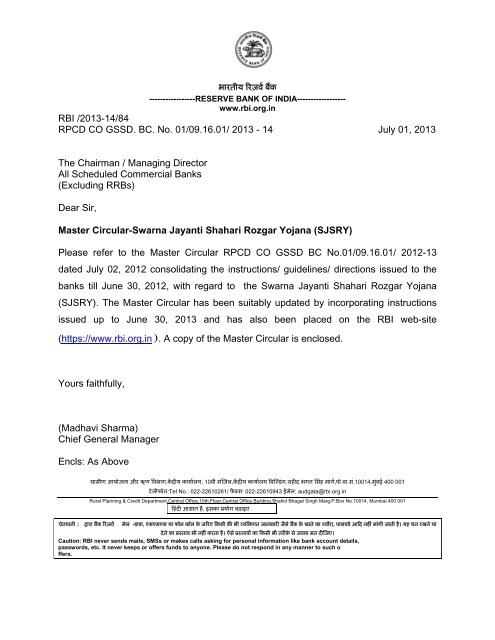

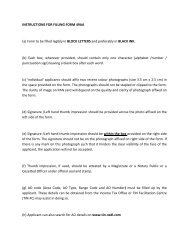
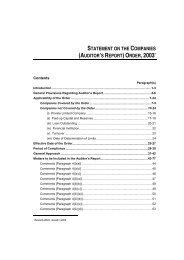
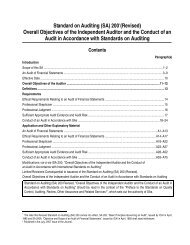
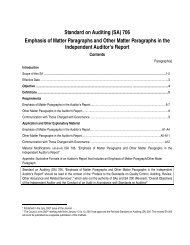
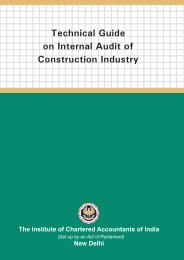
![FORM 1 [See sub-rule (1) of rule 3] FORM OF ... - CAalley.com](https://img.yumpu.com/49905825/1/190x245/form-1-see-sub-rule-1-of-rule-3-form-of-caalleycom.jpg?quality=85)
